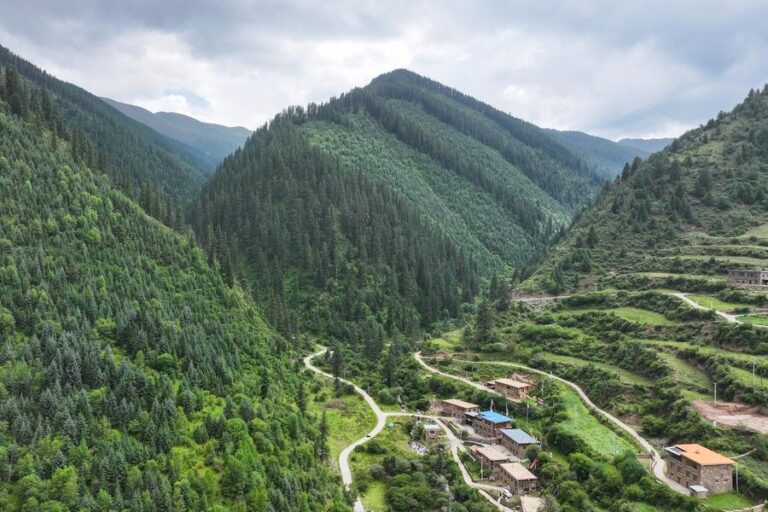* Located on the border of Qinghai and Sichuan provinces, Markog River is the largest, most concentrated and highest-altitude natural forest area at the headwaters of the Dadu River, which feeds into the Yangtze River, often referred to as China’s “mother river.”
* Over the past two decades, 115,000 mu (about 7,667 hectares) of afforestation has been completed and 220,000 mu (about 14,667 hectares) of existing forest has been tended in the Markog River forest area. The forest coverage rate has risen from 51 percent during the logging era to 69.58 percent.
* Over the past decade, local communities have gained over 60 million yuan (about 8.44 million U.S. dollars) in income through participation in ecological management, afforestation and seedling cultivation, creating a model in which residents both take part in and benefit from forest conservation.
XINING, Oct. 2 (Xinhua) — On an autumn morning in Padma County, Golog Tibetan Autonomous Prefecture of northwest China’s Qinghai Province, the Markog River forest comes alive with misty mountains, crystal-clear waters, lush shrubs and roaming wildlife.
Located on the border of Qinghai and Sichuan provinces, more than 800 km from the provincial capital Xining, the Markog River forest covers 101,800 hectares at an average altitude of 3,600 meters, with surrounding peaks soaring above 5,000 meters.
It is the largest, most concentrated and highest-altitude natural forest area at the headwaters of the Dadu River, which feeds into the Yangtze River, often referred to as China’s “mother river.” Over the past decades, the forest has undergone a profound transformation in its role and management.
FROM LOGGING TO CONSERVATION
The Markog River forest farm was established in 1965. In its early years, large quantities of timber were harvested to support economic development, recalled Tao Yongming, deputy director of the local forestry authority. Between 1965 and 1998, more than 700,000 cubic meters of trees were felled.
The turning point came in 1998, when Qinghai issued a notice banning commercial logging in natural forests. In response, the forestry bureau launched a pilot project to safeguard these resources, shifting its focus from timber harvesting to forest conservation and cultivation.
However, the transition was not easy. Halting logging brought a complete shift in production, leaving many workers and residents who depended on the forest feeling adrift at first. In the early years, with limited patrol forces, cases of illegal logging were uncovered almost every year.
As the source of the Yangtze, Yellow and Lancang rivers, Qinghai is known as China’s “water tower.” The Markog River forest is one of 18 sub-areas of the Sanjiangyuan National Nature Reserve and an important water conservation zone for the upper Yangtze.
The responsibility to protect this ecosystem prompted locals to take on the challenges of change.
Ju Ngaleg, a 58-year-old Tibetan herder, became an ecological ranger in 2005, overseeing more than 6,000 mu (400 hectares) of primary forest, alpine meadows and wildlife habitat.
“At first, when we encountered illegal logging during patrols, we often ended up arguing with the loggers. They even went so far as to secretly drain the fuel from my motorcycle. But with the combined efforts of the government and rangers, these illegal activities were curbed, fostering a healthier coexistence between the forest and grassland,” he said.
While older herders tried to make the most of the limited plots of land they had, younger ones began turning to the forest for new sources of income, developing local specialties for wider markets, according to Tao.
Over the past decade, local communities have gained over 60 million yuan (about 8.44 million U.S. dollars) in income through participation in ecological management, afforestation and seedling cultivation, creating a model in which residents both take part in and benefit from forest conservation.
Currently, the forest employs 259 “herder-rangers,” each earning a fixed annual income of 21,600 yuan.
FROM MANPOWER TO TECHNOLOGY
Given the vast area, manpower alone is not enough. In recent years, the local forestry authorities have turned to technology to strengthen conservation.
A comprehensive patrol system has been established, combining traditional foot and vehicle patrols with modern technologies such as drones and high-definition cameras.
Launched in October 2024, the forest and grassland monitoring system uses infrared sensors at night and visible-light cameras during the day, achieving near-complete coverage of the forest and ranger stations.
Drones, infrared wildlife cameras and GPS-based patrol terminals have become standard equipment for rangers, and even veteran rangers have adapted to using the new technology.
Numbers offer the clearest evidence of successful conservation. Over the past two decades, 115,000 mu of afforestation has been completed and 220,000 mu of existing forest has been tended in the Markog River forest area.
The forest coverage rate has risen from 51 percent during the logging era to 69.58 percent, while forest stock volume has grown from 4.2 million cubic meters to 4.8 million cubic meters.
With the overall environment improving, rare species have made a comeback.
The forest area is now home to 180 species of wild vertebrates, including 12 national first-class protected animals such as leopards and snow leopards, and 33 national second-class protected species such as brown bears and lynxes.
A total of 984 species of forest plants have been recorded, some of which are listed in China’s national catalog of protected wild plants.
“Markog River’s recovery of wildlife and forest resources has created a balanced, diverse and increasingly pristine ecosystem in the Yangtze headwaters,” said Du Pinggui, director of the Qinghai provincial forestry and grassland bureau. “This is of great significance to safeguarding ecological security across the entire Yangtze River basin.”
(Video reporters: Li Linhai and Du Xiaowei; video editors: Zhao Tianlin and Zhu Cong)■

